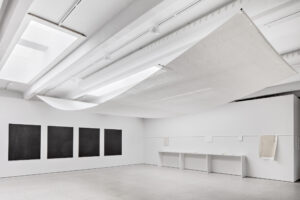Maria Taniguchi and Emilia Tanner are united by an uncompromising approach to vision, experience and material. Their practices straddle (and shift) the boundaries between image and process. Their works become embodiments of time: the time it took to make them and the time it takes to view them. The viewers’ understanding of the artists’ aims may be instantaneous, but only because the artists remain dedicated to the long-duration manual work required to articulate those aims as convincingly as possible.
The title for Kohta’s new duo exhibition, Figure, is fashionably succinct and ambiguous. It was chosen because it reads both as a noun and as a verb and because it is both assertive and deniable, implying both ‘fixity’ and ‘fiction’ but at the same time refraining from any ambition to be more than a ’scheme’. In classical Latin, figura (derived from a verb meaning ‘to form’) mirrored the Greek word schema (derived from a verb meaning ‘to hold’) and gathered a multiplicity of meanings, among them ‘outward appearance’, ‘written symbol or character’ and ‘image seen in a dream or vision’.
Figuration, understood in the conventional sense as representations of bodies and objects, is not what Taniguchi’s acrylic paintings on canvas or Tanner’s works on and with paper first bring to mind. Both artists allow their works to assume some of the characteristics of monochromes – black in Taniguchi’s case, white in Tanner’s – and set them up to be inward-looking rather than outwardly engaged. Rather than offering viewers means to figure out the world around them, the works constitute figures in their own right. It is as if, by proudly insisting on their own objecthood, they make a point of blocking out the view of anything beyond them. Put differently, Taniguchi’s and Tanner’s works perform immanence rather than transcendence. On the other hand they also let light shine through them, both literally and metaphorically.
Maria Taniguchi shows some of the ‘brick wall paintings’ that she has been making, alongside videos and sculptures, for more than a dozen years. The selection made among these numerous works, all untitled, includes one large-format stretched canvas (painted in 2015, measuring 275 × 487 cm) leaning against the wall and four wall-hung medium-sized variations of the same theme (painted in 2018, each measuring 152.5 × 122 cm). This almost imperceptibly mutating ongoing series is a convincing argument in favour of the hypothesis that some artists – they were never many – are capable of constant renewal while remaining unwaveringly loyal to one motif, always and never painting the same painting.
The paintings have a unified visual grid based on the simplest and most common repeating pattern in masonry, the stretcher bond. It may create a wall too thin to stand alone but is often used in modern construction to form the ‘skin’ or ‘face’ of a building. At the same time, the surfaces of individual paintings, especially the larger ones, disintegrate into patches of irregular shapes and sizes. Echoing the giornate of late medieval fresco painting, these testify to day-to-day fluctuations in humidity or air pressure that influence how the acrylic medium behaves on the canvas.
